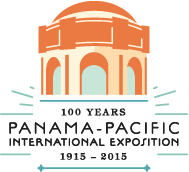One hundred years ago, San Francisco flaunted its recovery from the devastating 1906 earthquake and fire with the spectacular Panama-Pacific International Exposition. Not only did the city rise phoenix-like from its own ashes, but it transformed its northeastern waterfront into a lavish showcase for new ideas and innovations.
As Shelly Kale writes on the PPIE website:
 The goals of the fair, which ran from February 20 to December, 1915, transcended any expected economic boost for the city. In the exposition’s official history, published in 1921, San Francisco journalist Frank Morton Todd reflected on a lofty ambition: “to produce in San Francisco a microcosm so nearly complete that if all the world were destroyed except the 635 acres of land within the Exposition gates, the material basis of the life of today could have been reproduced from the exemplifications of the arts, inventions and industries there exhibited.”
The goals of the fair, which ran from February 20 to December, 1915, transcended any expected economic boost for the city. In the exposition’s official history, published in 1921, San Francisco journalist Frank Morton Todd reflected on a lofty ambition: “to produce in San Francisco a microcosm so nearly complete that if all the world were destroyed except the 635 acres of land within the Exposition gates, the material basis of the life of today could have been reproduced from the exemplifications of the arts, inventions and industries there exhibited.”
 The PPIE was only meant to show off innovations from the past decade. In 1915, this meant that audiences could watch a daring aviator fly stunts (or try a less alarming flight themselves). Laura Ackley, author of The Jewel City, adds: “Visitors could watch the assembly of a pair of Levi’s jeans or a brand new Ford, take in an avant-garde art display or listen to a speech by Teddy Roosevelt. They could see a temple molded entirely from soap or a tiny rosebush made of gems—or butter. When tired of riding around a six-acre replica Grand Canyon or a five-acre model of the Panama Canal, attendees could ascend nearly three hundred feet into the sky in a “house” attached to a steel arm. [They could also spend the night in a replica of Yellowstone’s Old Faithful Inn, or see Blackfoot Indians at the Glacier National Park exhibit.–CV] If the midway did not attract, they could enjoy a daily rotation of bands, parades, pageants, and headlining entertainers, including bandmaster John Philip Sousa, renowned composer Camille Saint-Saëns, and flamboyant dancer La Loïe Fuller.”
The PPIE was only meant to show off innovations from the past decade. In 1915, this meant that audiences could watch a daring aviator fly stunts (or try a less alarming flight themselves). Laura Ackley, author of The Jewel City, adds: “Visitors could watch the assembly of a pair of Levi’s jeans or a brand new Ford, take in an avant-garde art display or listen to a speech by Teddy Roosevelt. They could see a temple molded entirely from soap or a tiny rosebush made of gems—or butter. When tired of riding around a six-acre replica Grand Canyon or a five-acre model of the Panama Canal, attendees could ascend nearly three hundred feet into the sky in a “house” attached to a steel arm. [They could also spend the night in a replica of Yellowstone’s Old Faithful Inn, or see Blackfoot Indians at the Glacier National Park exhibit.–CV] If the midway did not attract, they could enjoy a daily rotation of bands, parades, pageants, and headlining entertainers, including bandmaster John Philip Sousa, renowned composer Camille Saint-Saëns, and flamboyant dancer La Loïe Fuller.”
 The National Park Service’s PPIE website notes:
The National Park Service’s PPIE website notes:
“New farming and agricultural technologies were also introduced; Luther Burbank, creator of many new kinds of plants including the Burbank potato, Santa Rosa plum, Shasta daisy, and the fire poppy was in charge of the Horticulture Palace. Author Laura Ingalls Wilder was particularly impressed with new dairy techniques—as she wrote, ‘I saw…cows being milked with a milk machine…it milked them clean and the cows did not object in the least.'”
Shelly Kale continues: “Among its many attractions, the fair boasted the world’s largest wood and steel building (the Palace of Machinery), the largest state building (the California Building), a juried exhibition described as the nation’s best modern art collection (the Palace of Fine Arts), the first transcontinental telephone call (made by Alexander Graham Bell to the fairgrounds before the fair opened), and indirect lighting for outdoor effects used for the first time at an exposition. Complementing the spectacular illuminations were “jewels” of polished crystal and colored glass accentuating architectural features, most visibly on the 43-stories-tall Tower of Jewels, giving the fair its nickname, the Jewel City.”
 Today the only building remaining from the Panama-Pacific International Exposition is Bernard Maybeck’s Palace of Fine Arts. And San Franciscans still enjoy Crissy Field, the grass airfield created on the site of the PPIE’s automobile track.
Today the only building remaining from the Panama-Pacific International Exposition is Bernard Maybeck’s Palace of Fine Arts. And San Franciscans still enjoy Crissy Field, the grass airfield created on the site of the PPIE’s automobile track.
There are illuminating activities and exhibits all over the city this year. If you’re here, be sure to see some! My personal favorite is the scale model of a large section of the PPIE brought out of storage and placed on show through December at the California Historical Society, 678 Mission St.


